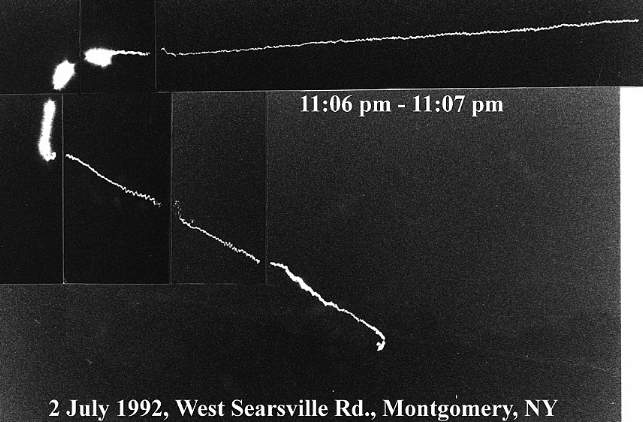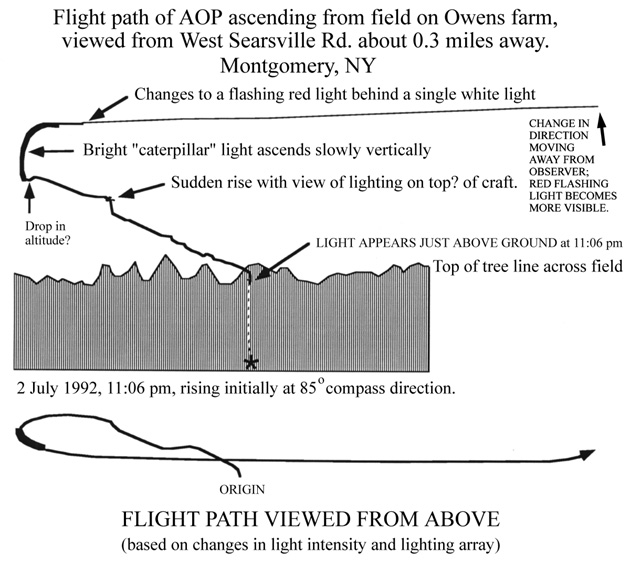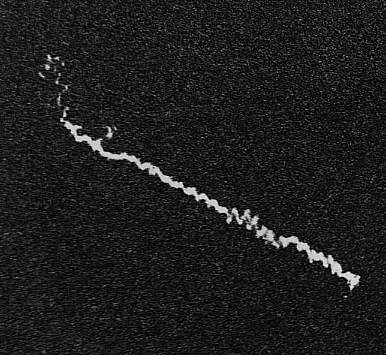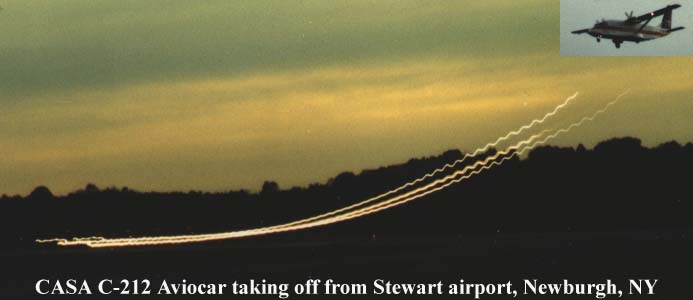
The Ascent
by Bruce Cornet, Ph.D.
On the night of 2 July 1992, Bruce Cornet, Fred Brock, and Evelyn Brock watched in utter amazement as a golden-white light began to rise from behind a row of trees across the field. They were standing next to the dog-leg bend in West Searsville Rd. between Montgomery and Pine Bush, NY, hoping that something unusual would happen, and it did. When the light was first spotted, it was very close to the ground. By the time Cornet had pointed his camera and opened the shutter, the light was near the tops of the trees, but still below their tops (visible in the first photograph). Cornet's Minolta 35mm SLR was securely mounted on top of a stable tripod. That night he was experimenting with a light-sensitive black & white film (ISO 3200), but this light was bright enough to be captured on a 100 ISO film. All time exposures were about 10 seconds in duration. As it rose the light jiggled, which can be seen in the photograph as irregular movement.


The light rose at a 45 degree angle towards the north until it had reached an altitude of about 150 feet, then brightened considerably. It slowly rose in a near vertical direction for about another 40 feet and stopped. It then began moving south. The light quickly dimmed to its previous intensity. A red strobe appeared, and the light moved off to the south at about the speed of a small airplane. All of this movement was done in complete silence. There was no sound of an aircraft engine.
When one examines the light traces in enlargements, it becomes clear that the movement of the light varied considerably, and that it moved in an up-and-down (sawtooth) fashion. Plumes of light come off the main light several times during its ascent: One plume can be seen in the first photograph at the beginning of the light trace, while another can be seen in the second photograph (below).

No burn marks or landing marks were found in the field from which it took off. This is the same field from which the 12 November 1993 AOP disappeared, and the same field from which the 13 July 1992 AOP originated. Most of the AOP activity which Cornet witnessed and recorded between 1992 and 1997 occurred near or above that field.
Conclusion
The flight path of this AOP excludes all aircraft dependent on wings for lift. The absence of audible sound does not preclude it from being a special type of helicopter, but its very uneven upwards flight path is unlike that of a helicopter or airplane taking off.
Below: An American Airlines commuter plane taking off at dusk.

The variation in light intensity, as well as the plumes of light that were caught on film coming off of the main light indicates an exotic light source, such as a plasma. The breaking up of the main light into five small lights at the end of the second photograph is particularly difficult to explain. The brightening of the light as it ascended vertically is also highly anomalous, especially the fuzzy perimeter to the light, which is unlike the effect produced by a search light. The appearance of a red strobe after it had reached cruising altitude is peculiar, considering that it had not yet reached a minimum FAA-approved altitude of 1,000 feet (it was below radar detection). The presence of that red strobe indicates a mechanical device, not an Earth light or ball lightning. All in all the performance of this light falls into the genuine category of unexplained or anomalous.
FAA regulation 91.515 Flight altitude rules: (a) Notwithstanding 91.119 and except as provided in paragraph (b) of this section, no person may operate an airplane under VFR at less than -- (1) One thousand feet above the surface, or 1,000 feet from any mountain, hill, or other obstruction to flight, for day operations; and (2) The altitudes prescribed in 91.177 for night operations. (b) This section does not apply -- (1) During takeoff or landing; (2) When a different altitude is authorized by a waiver to this section under subpart J of this part; or (3) When a flight is conducted under a special VFR weather minimum of 91.157 with an appropriate clearance from ATC.
FAA regulation 91.177 Minimum altitude for IFR operations. (a) Operation of aircraft at minimum altitudes. Except when necessary for takeoff and landing, no person may operate an aircraft under IFR below - (1) The applicable minimum altitudes prescribed in Parts 95 and 97 of this chapter; or (2) If no applicable minimum altitude is prescribed in those parts -- (i) In the case of operations over an area designated a mountainous area in part 95, an altitude of 2,000 feet above the highest obstacle within a horizontal distance of 4 nautical miles from the course to be flown; or (ii) In any other case, an altitude of 1,000 feet above the highest obstacle within a horizontal distance of 4 nautical miles from the course to be flown (AIM/FAR 1994 airman's information manual / federal aviation regulations).
Copyright B. Cornet 1999
Date this web page was last modified: 10/23/05